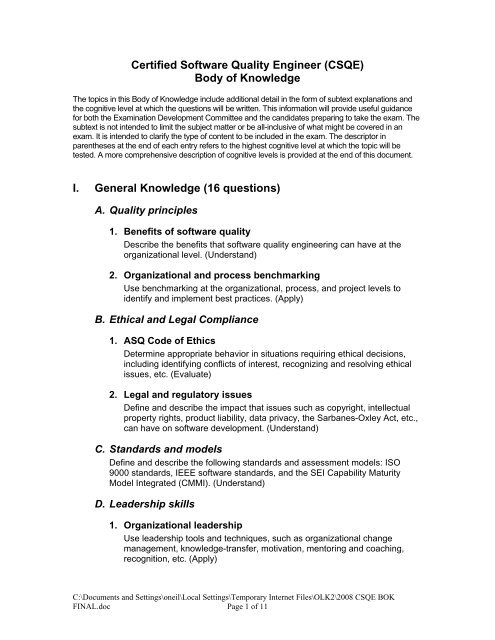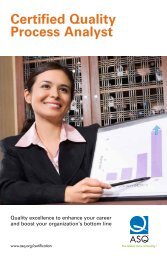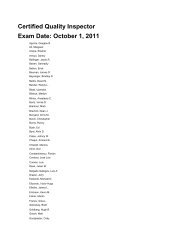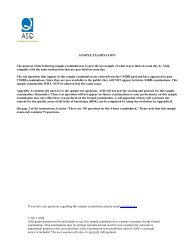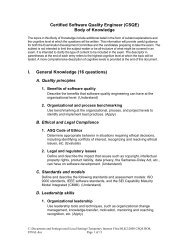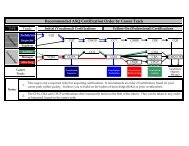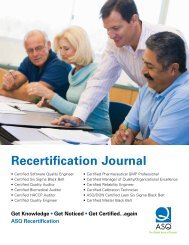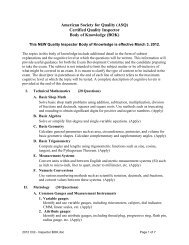Certified Software Quality Engineer (CSQE) Body of Knowledge - ASQ
Certified Software Quality Engineer (CSQE) Body of Knowledge - ASQ
Certified Software Quality Engineer (CSQE) Body of Knowledge - ASQ
Create successful ePaper yourself
Turn your PDF publications into a flip-book with our unique Google optimized e-Paper software.
<strong>Certified</strong> <strong>S<strong>of</strong>tware</strong> <strong>Quality</strong> <strong>Engineer</strong> (<strong>CSQE</strong>)<br />
<strong>Body</strong> <strong>of</strong> <strong>Knowledge</strong><br />
The topics in this <strong>Body</strong> <strong>of</strong> <strong>Knowledge</strong> include additional detail in the form <strong>of</strong> subtext explanations and<br />
the cognitive level at which the questions will be written. This information will provide useful guidance<br />
for both the Examination Development Committee and the candidates preparing to take the exam. The<br />
subtext is not intended to limit the subject matter or be all-inclusive <strong>of</strong> what might be covered in an<br />
exam. It is intended to clarify the type <strong>of</strong> content to be included in the exam. The descriptor in<br />
parentheses at the end <strong>of</strong> each entry refers to the highest cognitive level at which the topic will be<br />
tested. A more comprehensive description <strong>of</strong> cognitive levels is provided at the end <strong>of</strong> this document.<br />
I. General <strong>Knowledge</strong> (16 questions)<br />
A. <strong>Quality</strong> principles<br />
1. Benefits <strong>of</strong> s<strong>of</strong>tware quality<br />
Describe the benefits that s<strong>of</strong>tware quality engineering can have at the<br />
organizational level. (Understand)<br />
2. Organizational and process benchmarking<br />
Use benchmarking at the organizational, process, and project levels to<br />
identify and implement best practices. (Apply)<br />
B. Ethical and Legal Compliance<br />
1. <strong>ASQ</strong> Code <strong>of</strong> Ethics<br />
Determine appropriate behavior in situations requiring ethical decisions,<br />
including identifying conflicts <strong>of</strong> interest, recognizing and resolving ethical<br />
issues, etc. (Evaluate)<br />
2. Legal and regulatory issues<br />
Define and describe the impact that issues such as copyright, intellectual<br />
property rights, product liability, data privacy, the Sarbanes-Oxley Act, etc.,<br />
can have on s<strong>of</strong>tware development. (Understand)<br />
C. Standards and models<br />
Define and describe the following standards and assessment models: ISO<br />
9000 standards, IEEE s<strong>of</strong>tware standards, and the SEI Capability Maturity<br />
Model Integrated (CMMI). (Understand)<br />
D. Leadership skills<br />
1. Organizational leadership<br />
Use leadership tools and techniques, such as organizational change<br />
management, knowledge-transfer, motivation, mentoring and coaching,<br />
recognition, etc. (Apply)<br />
C:\Documents and Settings\oneil\Local Settings\Temporary Internet Files\OLK2\2008 <strong>CSQE</strong> BOK<br />
FINAL.doc Page 1 <strong>of</strong> 11
2. Facilitation skills<br />
Use various approaches to manage and resolve conflict. Use negotiation<br />
techniques and identify possible outcomes. Use meeting management tools<br />
to maximize performance. (Apply)<br />
3. Communication skills<br />
Use various communication elements (e.g., interviewing and listening skills)<br />
in oral, written, and presentation formats. Use various techniques for<br />
working in multi-cultural environments, and identify and describe the impact<br />
that culture and communications can have on quality. (Apply)<br />
E. Team Skills<br />
1. Team management<br />
Use various team management skills, including assigning roles and<br />
responsibilities, identifying the classic stages <strong>of</strong> team development<br />
(forming, storming, norming, performing, adjourning), monitoring and<br />
responding to group dynamics, and working with diverse groups and in<br />
distributed work environments. (Apply)<br />
2. Team tools<br />
Use decision-making and creativity tools, such as brainstorming, nominal<br />
group technique (NGT), multi-voting, etc. (Apply)<br />
II. <strong>S<strong>of</strong>tware</strong> <strong>Quality</strong> Management (26 questions)<br />
A. <strong>Quality</strong> Management System<br />
1. <strong>Quality</strong> goals and objectives<br />
Design quality goals and objectives for programs, projects, and products<br />
that are consistent with business objectives. Develop and use documents<br />
and processes necessary to support s<strong>of</strong>tware quality management<br />
systems. (Create)<br />
2. Customers and other stakeholders<br />
Describe and distinguish between various stakeholder groups, and analyze<br />
the effect their requirements can have on s<strong>of</strong>tware projects and products.<br />
(Analyze)<br />
3. Planning<br />
Design program plans that will support s<strong>of</strong>tware quality goals and<br />
objectives. (Evaluate)<br />
4. Outsourcing<br />
Determine the impact that acquisitions, multi-supplier partnerships,<br />
outsourced services, and other external drivers can have on organizational<br />
goals and objectives, and design appropriate criteria for evaluating<br />
suppliers and subcontractors. (Analyze)<br />
C:\Documents and Settings\oneil\Local Settings\Temporary Internet Files\OLK2\2008 <strong>CSQE</strong> BOK<br />
FINAL.doc Page 2 <strong>of</strong> 11
B. Methodologies<br />
1. Cost <strong>of</strong> quality (COQ)<br />
Analyze COQ categories (prevention, appraisal, internal failure, external<br />
failure) and their impact on products and processes. (Evaluate)<br />
2. Process improvement models<br />
Define and describe elements <strong>of</strong> lean tools and the six sigma methodology,<br />
and use the plan-do-check-act (PDCA) model for process improvement.<br />
(Apply)<br />
3. Corrective action procedures<br />
Evaluate corrective action procedures related to s<strong>of</strong>tware defects, process<br />
nonconformances, and other quality system deficiencies. (Evaluate)<br />
4. Defect prevention<br />
Design and use defect prevention processes such as technical reviews,<br />
s<strong>of</strong>tware tools and technology, special training, etc. (Evaluate)<br />
C. Audits<br />
1. Audit types<br />
Define and distinguish between various audit types, including process,<br />
compliance, supplier, system, etc. (Understand)<br />
2. Audit roles and responsibilities<br />
Identify roles and responsibilities for audit participants: client, lead auditor,<br />
audit team members and auditee. (Understand)<br />
3. Audit process<br />
Define and describe the steps in conducting an audit, developing and<br />
delivering an audit report, and determining appropriate follow-up activities.<br />
(Apply)<br />
III. Systems and <strong>S<strong>of</strong>tware</strong> <strong>Engineer</strong>ing Processes (27<br />
questions)<br />
A. Lifecycles and process models<br />
Evaluate various s<strong>of</strong>tware development lifecycles (iterative, waterfall, etc.) and<br />
process models (V-model, Feature Driven Development, Test Driven<br />
Development, etc.) and identify their benefits and when they should be used.<br />
(Evaluate)<br />
C:\Documents and Settings\oneil\Local Settings\Temporary Internet Files\OLK2\2008 <strong>CSQE</strong> BOK<br />
FINAL.doc Page 3 <strong>of</strong> 11
B. Systems architecture<br />
Identify and describe various architectures, including embedded systems,<br />
client-server, n-tier, web, wireless, messaging, collaboration platforms, etc.,<br />
and analyze their impact on quality. (Analyze)<br />
C. Requirements engineering<br />
1. Requirements types<br />
Define and describe various types <strong>of</strong> requirements, including feature,<br />
function, system, quality, security, safety, regulatory, etc. (Understand)<br />
2. Requirements elicitation<br />
Describe and use various elicitation methods, including customer needs<br />
analysis, use cases, human factors studies, usability prototypes, joint<br />
application development (JAD), storyboards, etc. (Apply)<br />
3. Requirements analysis<br />
Identify and use tools such as data flow diagrams (DFDs), entity<br />
relationship diagrams (ERDs), etc., to analyze requirements. (Apply)<br />
D. Requirements management<br />
1. Participants<br />
Identify various participants who have a role in requirements planning,<br />
including customers, developers, testers, the quality function, management,<br />
etc. (Understand)<br />
2. Requirements evaluation<br />
Assess the completeness, consistency, correctness and testability <strong>of</strong><br />
requirements, and determine their priority. (Evaluate)<br />
3. Requirements change management<br />
Assess the impact that changes to requirements will have on s<strong>of</strong>tware<br />
development processes for all types <strong>of</strong> lifecycle models. (Evaluate)<br />
4. Bidirectional traceability<br />
Use various tools and techniques to ensure bidirectional traceability from<br />
requirements elicitation and analysis through design and testing. (Apply)<br />
E. <strong>S<strong>of</strong>tware</strong> analysis, design, and development<br />
1. Design methods<br />
Identify the steps used in s<strong>of</strong>tware design and their functions, and define<br />
and distinguish between s<strong>of</strong>tware design methods such as object-oriented<br />
analysis and design (OOAD), structured analysis and design (SAD), and<br />
patterns. (Understand)<br />
C:\Documents and Settings\oneil\Local Settings\Temporary Internet Files\OLK2\2008 <strong>CSQE</strong> BOK<br />
FINAL.doc Page 4 <strong>of</strong> 11
2. <strong>Quality</strong> attributes and design<br />
Analyze the impact that quality-related elements (safety, security, reliability,<br />
usability, reusability, maintainability, etc.) can have on s<strong>of</strong>tware design.<br />
(Analyze)<br />
3. <strong>S<strong>of</strong>tware</strong> reuse<br />
Define and distinguish between s<strong>of</strong>tware reuse, reengineering, and reverse<br />
engineering, and describe the impact these practices can have on s<strong>of</strong>tware<br />
quality. (Understand)<br />
4. <strong>S<strong>of</strong>tware</strong> development tools<br />
Select the appropriate development tools to use for modeling, code<br />
analysis, etc., and analyze the impact they can have on requirements<br />
management and documentation. (Analyze)<br />
5. <strong>S<strong>of</strong>tware</strong> development methods<br />
Define and describe principles such as pair programming, extreme<br />
programming, cleanroom, formal methods, etc., and their impact on<br />
s<strong>of</strong>tware quality. (Understand)<br />
F. Maintenance management<br />
1. Maintenance types<br />
Describe the characteristics <strong>of</strong> corrective, adaptive, perfective, and<br />
preventive maintenance types. (Understand)<br />
2. Maintenance strategy<br />
Describe various factors affecting the strategy for s<strong>of</strong>tware maintenance,<br />
including service-level agreements (SLAs), short- and long-term costs,<br />
maintenance releases, product discontinuance, etc., and their impact on<br />
s<strong>of</strong>tware quality. (Understand)<br />
IV. Project Management (24 questions)<br />
A. Planning, scheduling, and deployment<br />
1. Project planning<br />
Use forecasts, resources, schedules, task and cost estimates, etc., to<br />
develop project plans. (Apply)<br />
2. Project scheduling<br />
Use PERT charts, critical path method (CPM), work breakdown structure<br />
(WBS), Scrum, burn-down charts, and other tools to schedule and monitor<br />
projects. (Apply)<br />
3. Project deployment<br />
Use various tools, including milestones, objectives achieved, task duration,<br />
etc., to set goals and deploy the project. (Apply)<br />
C:\Documents and Settings\oneil\Local Settings\Temporary Internet Files\OLK2\2008 <strong>CSQE</strong> BOK<br />
FINAL.doc Page 5 <strong>of</strong> 11
B. Tracking and controlling<br />
1. Phase transition control<br />
Use phase transition control tools and techniques such as entry/exit criteria,<br />
quality gates, Gantt charts, integrated master schedules, etc. (Apply)<br />
2. Tracking methods<br />
Calculate project-related costs, including earned value, deliverables,<br />
productivity, etc., and track the results against project baselines. (Apply)<br />
3. Project reviews<br />
Use various types <strong>of</strong> project reviews such as phase-end, management, and<br />
retrospectives or post-project reviews to assess project performance and<br />
status, to review issues and risks, and to discover and capture lessons<br />
learned from the project. (Apply)<br />
4. Program reviews<br />
Define and describe various methods for reviewing and assessing<br />
programs in terms <strong>of</strong> their performance, technical accomplishments,<br />
resource utilization, etc. (Understand)<br />
C. Risk management<br />
1. Risk management methods<br />
Use risk management techniques (assess, prevent, mitigate, transfer) to<br />
evaluate project risks. (Evaluate)<br />
2. <strong>S<strong>of</strong>tware</strong> security risks<br />
Evaluate risks specific to s<strong>of</strong>tware security, including deliberate attacks<br />
(hacking, sabotage, etc.), inherent defects that allow unauthorized access<br />
to data, and other security breaches, and determine appropriate responses<br />
to minimize their impact. (Evaluate)<br />
3. Safety and hazard analysis<br />
Evaluate safety risks and hazards related to s<strong>of</strong>tware development and<br />
implementation and determine appropriate steps to minimize their impact.<br />
(Evaluate)<br />
V. <strong>S<strong>of</strong>tware</strong> Metrics and Analysis (24 questions)<br />
A. Metrics and measurement theory<br />
1. Terminology<br />
Define and describe metrics and measurement terms including reliability,<br />
internal and external validity, explicit and derived measures, etc.<br />
(Understand)<br />
C:\Documents and Settings\oneil\Local Settings\Temporary Internet Files\OLK2\2008 <strong>CSQE</strong> BOK<br />
FINAL.doc Page 6 <strong>of</strong> 11
2. Basic measurement theory and statistics<br />
Define the central limit theorem, and describe and use mean, median,<br />
mode, standard deviation, variance, and range. Apply appropriate<br />
measurement scales (nominal, ordinal, ratio, interval) in various situations.<br />
(Apply)<br />
3. Psychology <strong>of</strong> metrics<br />
Describe how metrics and measuring affect the people whose work is being<br />
measured and how people affect the ways in which metrics are used and<br />
data are gathered. (Understand)<br />
B. Process and product measurement<br />
1. <strong>S<strong>of</strong>tware</strong> metrics<br />
Use metrics to assess various s<strong>of</strong>tware attributes such as size, complexity,<br />
number <strong>of</strong> defects, the amount <strong>of</strong> test coverage needed, requirements<br />
volatility, and overall system performance. (Apply)<br />
2. Process metrics<br />
Measure the effectiveness and efficiency <strong>of</strong> s<strong>of</strong>tware using functional<br />
verification tests (FVT), cost, yield, customer impact, defect detection,<br />
defect containment, total defect containment effectiveness (TDCE), defect<br />
removal efficiency (DRE), process capability and efficiency, etc. (Apply)<br />
3. Metrics reporting tools<br />
Use various metric representation tools, including dashboards, stoplight<br />
charts, etc., to report results efficiently. (Apply)<br />
C. Analytical techniques<br />
1. Sampling<br />
Define and distinguish between sampling methods (e.g., random, stratified,<br />
cluster) as used in auditing, testing, product acceptance, etc. (Understand)<br />
2. Data collection and integrity<br />
Describe the importance <strong>of</strong> data integrity from planning through collection<br />
and analysis, and apply various techniques to ensure its quality, accuracy,<br />
completeness, and timeliness. (Apply)<br />
3. <strong>Quality</strong> analysis tools<br />
Describe and use classic quality tools (flowcharts, Pareto charts, cause and<br />
effect diagrams, control charts, histograms, etc.) and problem-solving tools<br />
(affinity and tree diagrams, matrix and activity network diagrams, root cause<br />
analysis, etc.) in a variety <strong>of</strong> situations. (Apply)<br />
C:\Documents and Settings\oneil\Local Settings\Temporary Internet Files\OLK2\2008 <strong>CSQE</strong> BOK<br />
FINAL.doc Page 7 <strong>of</strong> 11
VI. <strong>S<strong>of</strong>tware</strong> Verification and Validation (V&V) (27 questions)<br />
A. Theory<br />
1. V&V methods<br />
Select and use V&V methods, including static analysis, structural analysis,<br />
mathematical pro<strong>of</strong>, simulation, etc., and analyze which tasks should be<br />
iterated as a result <strong>of</strong> modifications. (Analyze)<br />
2. <strong>S<strong>of</strong>tware</strong> product evaluation<br />
Use various evaluation methods on documentation, source code, test<br />
results, etc., to determine whether user needs and project objectives have<br />
been satisfied. (Analyze)<br />
B. Test planning and design<br />
1. Test strategies<br />
Select and analyze test strategies (test-driven design, good-enough, riskbased,<br />
time-box, top-down, bottom-up, black-box, white-box, simulation,<br />
automation, etc.) for various situations. (Analyze)<br />
2. Test plans<br />
Develop and evaluate test plans and procedures, including system,<br />
acceptance, validation, etc., to determine whether project objectives are<br />
being met. (Create)<br />
3. Test designs<br />
Select and evaluate various test designs, including fault insertion, fault-error<br />
handling, equivalence class partitioning, boundary value, etc. (Evaluate)<br />
4. <strong>S<strong>of</strong>tware</strong> tests<br />
Identify and use various tests, including unit, functional, performance,<br />
integration, regression, usability, acceptance, certification, environmental<br />
load, stress, worst-case, perfective, exploratory, system, etc. (Apply)<br />
5. Tests <strong>of</strong> supplier components and products<br />
Determine appropriate levels <strong>of</strong> testing for integrating third-party<br />
components and products. (Apply)<br />
6. Test coverage specifications<br />
Evaluate the adequacy <strong>of</strong> specifications such as functions, states, data and<br />
time domains, interfaces, security, and configurations that include<br />
internationalization and platform variances. (Evaluate)<br />
7. Code coverage techniques<br />
Identify and use techniques such as branch-to-branch, condition, domain,<br />
McCabe's cyclomatic complexity, boundary, etc. (Apply)<br />
C:\Documents and Settings\oneil\Local Settings\Temporary Internet Files\OLK2\2008 <strong>CSQE</strong> BOK<br />
FINAL.doc Page 8 <strong>of</strong> 11
8. Test environments<br />
Select and use simulations, test libraries, drivers, stubs, harnesses, etc.,<br />
and identify parameters to establish a controlled test environment in various<br />
situations. (Analyze)<br />
9. Test tools<br />
Identify and use utilities, diagnostics, and test management tools. (Apply)<br />
C. Reviews and inspections<br />
Identify and use desk-checks, peer reviews, walk-throughs, Fagan and Gilb<br />
inspections, etc. (Apply)<br />
D. Test execution documentation<br />
Review and evaluate documents such as defect reporting and tracking records,<br />
test completion metrics, trouble reports, input/output specifications, etc.<br />
(Evaluate)<br />
E. Customer deliverables<br />
Assess the completeness <strong>of</strong> customer deliverables, including packaged and<br />
hosted or downloadable products, license keys and user documentation,<br />
marketing and training materials, etc. (Evaluate)<br />
VII. <strong>S<strong>of</strong>tware</strong> Configuration Management (16 questions)<br />
A. Configuration infrastructure<br />
1. Configuration management team<br />
Describe the roles and responsibilities <strong>of</strong> a configuration management<br />
group. (Understand)<br />
[NOTE: The roles and responsibilities <strong>of</strong> the configuration control board<br />
(CCB) are covered in area VII.C.2.]<br />
2. Configuration management tools<br />
Describe these tools as they are used for managing libraries, build systems,<br />
defect tracking systems, etc. (Understand)<br />
3. Library processes<br />
Describe dynamic, static, and controlled processes used in library systems<br />
and related procedures, such as check-in/check-out, merge changes, etc.<br />
(Understand)<br />
B. Configuration identification<br />
1. Configuration items<br />
Describe configuration items (documentation, s<strong>of</strong>tware code, equipment,<br />
etc.), identification methods (naming conventions, versioning schemes,<br />
etc.), and when baselines are created and used. (Understand)<br />
C:\Documents and Settings\oneil\Local Settings\Temporary Internet Files\OLK2\2008 <strong>CSQE</strong> BOK<br />
FINAL.doc Page 9 <strong>of</strong> 11
2. <strong>S<strong>of</strong>tware</strong> builds<br />
Describe the relationship between s<strong>of</strong>tware builds and configuration<br />
management functions, and describe methods for controlling builds<br />
(automation, new versions, etc.). (Understand)<br />
C. Configuration control and status accounting<br />
1. Item, baseline, and version control<br />
Describe processes for documentation control, tracking item changes,<br />
version control, etc., that are used to manage various configurations, and<br />
describe processes used to manage configuration item dependencies in<br />
s<strong>of</strong>tware builds and versioning. (Understand)<br />
2. Configuration control board (CCB)<br />
Describe the roles and responsibilities <strong>of</strong> the CCB and its members and the<br />
procedures they use. (Understand)<br />
[NOTE: The roles and responsibilities <strong>of</strong> the configuration management<br />
team are covered in area VII.A.1.]<br />
3. Concurrent development<br />
Describe the use <strong>of</strong> configuration management control principles in<br />
concurrent development processes. (Understand)<br />
4. Status accounting<br />
Discuss various processes for establishing, maintaining, and reporting the<br />
status <strong>of</strong> configuration items. (Understand)<br />
D. Configuration audits<br />
Define and distinguish between functional and physical configuration audits<br />
and how they are used in relation to product specifications. (Understand)<br />
E. Product release and distribution<br />
1. Product release<br />
Review product release processes (planning, scheduling, defining hardware<br />
and s<strong>of</strong>tware dependencies, etc.) and assess their effectiveness. (Evaluate)<br />
2. Archival processes<br />
Review the source and release archival processes (backup planning and<br />
scheduling, data retrieval, archival <strong>of</strong> build environments, retention <strong>of</strong><br />
historical records, <strong>of</strong>fsite storage, etc.) and assess their effectiveness.<br />
(Evaluate)<br />
C:\Documents and Settings\oneil\Local Settings\Temporary Internet Files\OLK2\2008 <strong>CSQE</strong> BOK<br />
FINAL.doc Page 10 <strong>of</strong> 11
Levels <strong>of</strong> Cognition<br />
Based on Bloom’s Taxonomy – Revised (2001)<br />
In addition to content specifics, the subtext for each topic in this BOK also<br />
indicates the intended complexity level <strong>of</strong> the test questions for that topic.<br />
These levels are based on “Levels <strong>of</strong> Cognition” (from Bloom’s Taxonomy –<br />
Revised, 2001) and are presented below in rank order, from least complex to<br />
most complex.<br />
Remember<br />
Recall or recognize terms, definitions, facts, ideas, materials, patterns, sequences,<br />
methods, principles, etc.<br />
Understand<br />
Read and understand descriptions, communications, reports, tables, diagrams,<br />
directions, regulations, etc.<br />
Apply<br />
Know when and how to use ideas, procedures, methods, formulas, principles, theories,<br />
etc.<br />
Analyze<br />
Break down information into its constituent parts and recognize their relationship to one<br />
another and how they are organized; identify sublevel factors or salient data from a<br />
complex scenario.<br />
Evaluate<br />
Make judgments about the value <strong>of</strong> proposed ideas, solutions, etc., by comparing the<br />
proposal to specific criteria or standards.<br />
Create<br />
Put parts or elements together in such a way as to reveal a pattern or structure not<br />
clearly there before; identify which data or information from a complex set is appropriate<br />
to examine further or from which supported conclusions can be drawn.<br />
C:\Documents and Settings\oneil\Local Settings\Temporary Internet Files\OLK2\2008 <strong>CSQE</strong> BOK<br />
FINAL.doc Page 11 <strong>of</strong> 11


